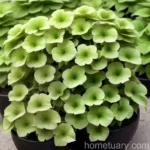The Allure of Shrub Roses: A Focus on Rosa ‘Ausmas’ Graham Thomas
Shrub roses are versatile and charming plants that add a touch of elegance and natural beauty to any garden. Among the vast array of shrub rose varieties, one particular standout is the Rosa ‘Ausmas’ Graham Thomas, a delightful specimen renowned for its captivating features and easy maintenance requirements. In this comprehensive guide, we will delve into the world of Rosa ‘Ausmas’ Graham Thomas and explore its culture, uses, care, and more. Whether you are a novice gardener or a seasoned horticulturist, there will be something new and insightful to discover about this enchanting shrub rose.
What is a Shrub Rose?
Shrub roses, as the name suggests, are roses that grow in a shrubby, bush-like form. They are distinct from traditional hybrid tea roses or climbing roses and are valued for their vigor, hardiness, and beautiful, often fragrant blooms. They come in a wide range of colors, sizes, and growth habits, making them a versatile choice for various garden settings.
Key Takeaways: Shrub Rose (Rosa ‘Ausmas’ Graham Thomas)
Before we delve deeper into the specific details of Rosa ‘Ausmas’ Graham Thomas, let’s take a moment to highlight the essential characteristics and key takeaways associated with this lovely shrub rose:
- Shrub Rose Varieties: Rosa ‘Ausmas’ Graham Thomas belongs to the broader category of shrub roses, which encompass an extensive assortment of cultivars, each with its own unique attributes.
- Culture: Understanding the optimal conditions for culture, including sunlight, water, and soil preferences, is crucial for the successful growth and development of shrub roses.
- Uses: Shrub roses like Rosa ‘Ausmas’ Graham Thomas can be used for a variety of landscaping and gardening purposes, from standalone ornamental plants to hedge plantings and mixed borders.
- Pruning: Regular and appropriate pruning is essential for maintaining the health, shape, and flowering performance of shrub roses.
- Propagation: The propagation methods for shrub roses, including Rosa ‘Ausmas’ Graham Thomas, can vary and may include techniques such as stem cuttings or grafting.
- Common Diseases and Pests: Like all plants, shrub roses are susceptible to certain diseases and pests, and understanding how to prevent, identify, and manage these issues is vital.
Now, with these key points in mind, let’s explore the specific details of Rosa ‘Ausmas’ Graham Thomas, from its cultural requirements to its unique characteristics and uses.
Rosa ‘Ausmas’ Graham Thomas: Unveiling the Beauty
Rosa ‘Ausmas’ Graham Thomas, often referred to simply as Graham Thomas, is a beloved shrub rose cultivar that has captured the hearts of gardeners and rose enthusiasts around the world. This exquisite rose, introduced by David Austin Roses, is celebrated for its exceptional qualities, making it a standout choice for garden landscapes and outdoor spaces.
Culture
Cultivating Rosa ‘Ausmas’ Graham Thomas involves understanding and providing the optimal conditions for its growth and blooming. Let’s explore the key cultural requirements for this charming shrub rose:
Water
Proper watering is essential for the health and vitality of Rosa ‘Ausmas’ Graham Thomas. While shrub roses are generally resilient, they benefit from consistent moisture, especially during dry spells or in warm climates. When watering your Graham Thomas rose:
- Regular Watering: Provide regular watering, ensuring that the soil remains evenly moist but not waterlogged.
- Deep Watering: When irrigating, aim for deep watering to encourage root development and drought tolerance.
- Mulching: Consider applying a layer of organic mulch around the base of the plant to help retain soil moisture and suppress weed growth.
Sunlight
Like many roses, Rosa ‘Ausmas’ Graham Thomas thrives in ample sunlight. When considering its sunlight requirements:
- Full Sun Exposure: Aim to plant Graham Thomas in a location that receives at least 6-8 hours of direct sunlight daily.
- Morning Sun: If possible, prioritize morning sunlight, as it helps to dry dew from the leaves, reducing the risk of fungal diseases.
- Sheltered Locations: While Graham Thomas appreciates sunlight, it can also benefit from some protection against intense afternoon heat, especially in hotter climates.
Fertilizer
Proper fertilization supports the vigorous growth and abundant flowering of Rosa ‘Ausmas’ Graham Thomas. Consider the following guidelines for fertilizing your shrub rose:
- Balanced Fertilizer: Use a balanced, slow-release fertilizer formulated specifically for roses or flowering shrubs.
- Early Spring Application: Apply the first round of fertilizer in early spring as new growth begins, following the product’s recommended rates.
- Subsequent Feedings: Depending on the fertilizer type, additional applications may be needed throughout the growing season, typically in late spring or early summer.
Soil
The soil composition plays a crucial role in the overall health and performance of Rosa ‘Ausmas’ Graham Thomas. Here are the key considerations for soil preparation and maintenance:
- Well-Draining Soil: Ensure that the planting site provides well-draining soil to prevent waterlogging, which can lead to root rot and other moisture-related issues.
- Amendments: If the native soil is heavy or lacks organic matter, consider amending it with compost or well-rotted manure to improve its structure and fertility.
- Soil pH: Aim for a slightly acidic to neutral soil pH range, ideally between 6.0 and 7.0, to support optimal nutrient uptake and overall plant health.
Pruning
Pruning is an essential aspect of shrub rose care, including Rosa ‘Ausmas’ Graham Thomas. Proper pruning helps maintain the shrub’s shape, remove dead or diseased wood, and encourage robust flowering. When pruning your Graham Thomas rose:
- Timing: Conduct major pruning in late winter or early spring, before new growth emerges, to prepare the plant for the upcoming growing season.
- Deadheading: Regularly remove spent blooms to promote continuous flowering and prevent the formation of rose hips.
- Thinning and Shaping: As needed, thin out crowded branches and shape the shrub to maintain an open, airy structure that allows for good air circulation.
Propagation
For those interested in propagating Rosa ‘Ausmas’ Graham Thomas, several methods can be employed to create new plants. Common propagation techniques for shrub roses, including Graham Thomas, include:
- Softwood Cuttings: During the active growing season, take softwood cuttings from healthy, non-flowering shoots and propagate them in a suitable rooting medium.
- Layering: Encourage the growth of new roots by carefully layering a flexible stem of the rose to the soil, creating a new plant that can be later separated from the parent.
- Grafting: Professional and advanced amateur gardeners may opt for grafting, a method that involves joining the desirable Graham Thomas cultivar onto a compatible rootstock.
Container Popularity
Beyond traditional garden plantings, Rosa ‘Ausmas’ Graham Thomas has gained popularity for container gardening. When growing Graham Thomas roses in containers:
- Container Size: Select a sufficiently large and sturdy container, ensuring that it provides ample room for root development and stability for the growing shrub.
- Well-Draining Mix: Use a high-quality, well-draining potting mix, ideally formulated for roses or other flowering shrubs, to support healthy growth in containers.
- Consistent Care: Container-grown shrub roses may require more frequent watering and fertilization compared to their in-ground counterparts, so maintain consistent care and monitoring.
Common Diseases
While Rosa ‘Ausmas’ Graham Thomas exhibits good resistance to several common rose diseases, it is important to be vigilant and take preventive measures to protect the plant from potential issues. Some prevalent rose diseases that may affect Graham Thomas include:
- Powdery Mildew: A fungal disease that appears as a white powdery coating on the leaves and can affect plant vigor and aesthetics.
- Black Spot: Another common fungal disease, characterized by dark spots on the foliage, leading to defoliation and weakening of the plant.
- Botrytis Blight: Also known as gray mold, this disease can cause flower buds to rot and affect the overall health of the plant.
Disease Diagnosis
Early detection and proper diagnosis of rose diseases play a critical role in effective management. When monitoring and diagnosing potential diseases on your Graham Thomas roses:
- Visual Inspection: Regularly inspect the foliage, stems, and blooms for any signs of discoloration, spots, or unusual growth.
- Symptom Identification: Learn to recognize the specific symptoms associated with common rose diseases to facilitate timely intervention.
- Professional Consultation: If you are unsure about a particular disease or its management, seek advice from local horticultural experts or plant disease specialists.
Common Pests
In addition to diseases, shrub roses like Rosa ‘Ausmas’ Graham Thomas can also attract certain pests that may impact their health and appearance. Common pests to watch out for include:
- Aphids: Small, sap-sucking insects that can colonize tender new growth and flower buds, leading to distorted or yellowing foliage.
- Japanese Beetles: These voracious beetles can cause significant damage by feeding on the leaves and flowers of roses, often skeletonizing the foliage.
- Spider Mites: These tiny arachnids can infest the undersides of leaves, causing stippling and discoloration as they feed on plant juices.
Botanist’s Tips
Drawing from expert insights and practical experience, here are some valuable tips and recommendations for anyone cultivating Rosa ‘Ausmas’ Graham Thomas or other shrub roses:
- Regular Monitoring: Stay attentive to the overall health and appearance of your Graham Thomas rose, regularly assessing its foliage, stems, and blooms for any signs of distress or disease.
- Appropriate Pruning: Adhere to recommended pruning techniques, ensuring that you remove dead, damaged, or crossing branches while maintaining the shrub’s natural shape and form.
- Adequate Air Circulation: Strive to provide good air circulation around the shrub, as this can help reduce the risk of fungal diseases and maintain the overall vigor of the plant.
Fun Facts
To add a touch of fascination to your knowledge of Rosa ‘Ausmas’ Graham Thomas, here are some fun and intriguing facts about this captivating shrub rose:
- Named in Honor: Rosa ‘Ausmas’ Graham Thomas was named in honor of the renowned English horticulturist Graham Stuart Thomas, a figure celebrated for his contributions to garden design and rose cultivation.
- Scent and Color: The blooms of Graham Thomas exude a delightful, strong, and fruity fragrance, and they display a warm, deep yellow color that adds a radiant glow to garden settings.
- Versatile Landscaping: This shrub rose is well-suited for various landscaping uses, from being standalone specimen plants to combining seamlessly with other perennials and flowering shrubs in mixed borders or cottage garden settings.
Links to External Resources
For further exploration and in-depth information on shrub roses, including Rosa ‘Ausmas’ Graham Thomas, consider the following external resources:
- Royal Horticultural Society – Growing Roses
- American Rose Society
- University of California Integrated Pest Management – Roses
In conclusion, the allure of shrub roses, exemplified by the remarkable Rosa ‘Ausmas’ Graham Thomas, embodies the enduring charm and appeal of these beloved garden plants. Whether adorning a border, enhancing a container display, or gracing a cottage garden, the unique qualities and cultural significance of Graham Thomas roses make them a cherished addition to any landscape. As you embark on your journey of growing and appreciating shrub roses, may the insights shared in this guide enrich your gardening experience and deepen your admiration for these exquisite blooms.
Remember, cultivating Rosa ‘Ausmas’ Graham Thomas is not merely an act of horticulture; it is a celebration of nature’s beauty and an expression of your love for the living tapestry of the garden. With attentive care and a touch of botanical artistry, your Graham Thomas roses will undoubtedly flourish, inspiring admiration and delight with their timeless elegance.
Happy gardening, and may your landscapes bloom with the enduring allure of shrub roses!
Keywords: Shrub rose varieties, Popular shrub roses, Rosa ‘Ausmas’ Graham Thomas, Shrub rose care tips, Growing shrub roses, Types of shrub roses, Shrub rose pruning techniques, Shrub rose planting guide, Shrub rose diseases and pests, Shrub rose cultivation, Shrub rose maintenance, Shrub rose landscaping ideas, Best companion plants for shrub roses, Shrub rose propagation methods, Shrub rose fertilization, Shrub rose watering schedule, Shrub rose winter protection, Shrub rose color variations, Shrub rose scent characteristics, Shrub rose blooming season, Shrub rose varieties for containers, Shrub rose benefits for pollinators, Shrub rose hybridization, Shrub rose fragrance levels, Shrub rose pruning frequency, Shrub rose soil requirements, Shrub rose drainage needs, Shrub rose sunlight preferences, Shrub rose watering techniques, Shrub rose disease prevention, Shrub rose companion planting tips, Shrub rose container gardening, Shrub rose trimming techniques, Shrub rose pest control methods, Shrub rose seasonal care, Shrub rose landscape design, Shrub rose gardening hacks, Shrub rose root development, Shrub rose leaf characteristics, Shrub rose bud formation, Shrub rose growth patterns, Shrub rose propagation tips, Shrub rose natural remedies for pests, Shrub rose winter dormancy, Shrub rose pruning tools, Shrub rose disease identification, Shrub rose watering frequency, Shrub rose sunlight requirements, Shrub rose landscaping inspiration, Shrub rose fertilization techniques















